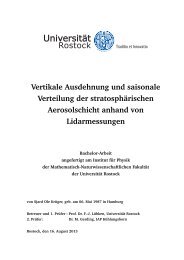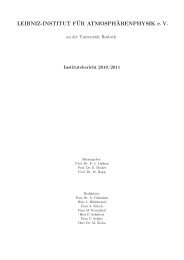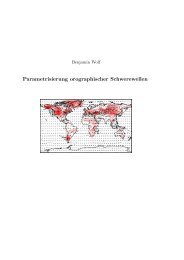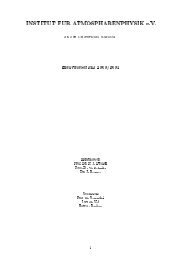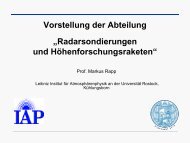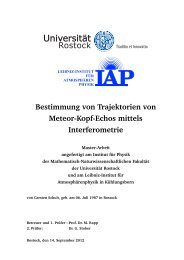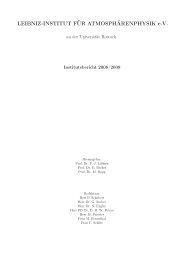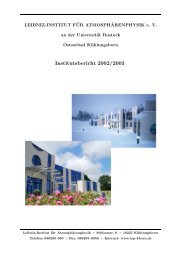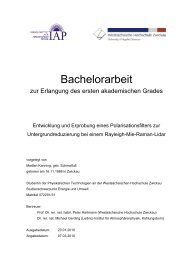Polar mesosphere summer echoes (PMSE): review of ... - HAL
Polar mesosphere summer echoes (PMSE): review of ... - HAL
Polar mesosphere summer echoes (PMSE): review of ... - HAL
Create successful ePaper yourself
Turn your PDF publications into a flip-book with our unique Google optimized e-Paper software.
M. Rapp and F. J. Lübken: Review <strong>of</strong> <strong>PMSE</strong> 2611<br />
Fig. 12. Left panel: Pr<strong>of</strong>ile <strong>of</strong> the radar signal to noise ratio (SNR)<br />
measured with the ALOMAR-SOUSY VHF radar during sounding<br />
rocket flight ECT02. Right panel: pr<strong>of</strong>iles <strong>of</strong> electron number<br />
densities (black line) and aerosol charge number densities (red<br />
line) measured during sounding rocket flight ECT02. These data<br />
are taken from Havnes et al. (1996b) and Lübken et al. (1998).<br />
Fig. 13. Scatter plot showing the dependence <strong>of</strong> the <strong>PMSE</strong> SNR<br />
values on the electron number densities at 87 km during the major<br />
solar proton event on 14 July 2000. While no correlation is<br />
detectable for electron number densities lower than ∼7·10 4 /cm 3 a<br />
clear anti-correlation is observed for higher electron number densities.<br />
This figure is reproduced from Rapp et al. (2002a), copyright<br />
by the American Geophysical Union.<br />
2.4.4 Observation <strong>of</strong> charged ice particles<br />
While the observation <strong>of</strong> electron biteouts, the occurrence <strong>of</strong><br />
<strong>PMSE</strong> in the vicinity <strong>of</strong> noctilucent clouds (see Sect. 2.5),<br />
and the tight coupling <strong>of</strong> the seasonal dependence <strong>of</strong> <strong>PMSE</strong><br />
and NLC occurrence provided strong evidence that <strong>PMSE</strong><br />
are closely related to aerosol particles, the first direct in situ<br />
measurement <strong>of</strong> (charged) ice particles 1 in an <strong>PMSE</strong> environment<br />
must be considered as one <strong>of</strong> the major steps towards an<br />
understanding <strong>of</strong> <strong>PMSE</strong>. The pioneering work was done by<br />
Havnes et al. (1996b) who applied a Faraday-cup-like instrument<br />
(the ‘DUSTY’-detector) to measure the charge number<br />
density associated with the particles. Figure 12 shows<br />
the first altitude pr<strong>of</strong>ile <strong>of</strong> charged aerosol particles measured<br />
during the ECHO sounding rocket campaign from the Norwegian<br />
Andøya Rocket Range on 28 July 1994. Havnes<br />
et al. (1996b) observed negatively charged particles in two<br />
distinct layers, one centered at 87.5 km and the other centered<br />
at 85.5 km altitude. Most interestingly, the measurement<br />
<strong>of</strong> the number density <strong>of</strong> free electrons made on the<br />
same sounding rocket revealed two distinct electron biteouts<br />
exactly at the same altitudes indicating that biteouts form because<br />
the aerosol particles act as an efficient sink for electrons<br />
(and hence acquire a net negative charge; see Sect. 3).<br />
During the same campaign, Havnes et al. (1996b) also observed<br />
a layer <strong>of</strong> positively charged aerosol particles collocated<br />
with an electron enhancement (instead <strong>of</strong> the more<br />
common biteout) in the altitude range where a noctilucent<br />
1 Note that we distinguish between particles and large cluster<br />
ions: while the largest cluster ions reported from measurements in<br />
the <strong>mesosphere</strong> so far had masses <strong>of</strong> less than a couple <strong>of</strong> hundred<br />
amu, particles are considered to be more massive than several thousand<br />
amu.<br />
cloud was observed by a ground based lidar. These measurements<br />
are however much more difficult to explain than the<br />
observations <strong>of</strong> negatively charged particles. In subsequent<br />
campaigns, several investigations have provided further evidence<br />
for the existence <strong>of</strong> negatively charged aerosol particles<br />
in <strong>PMSE</strong> (Havnes et al., 2001; Mitchell et al., 2001,<br />
2003; Smiley et al., 2003). Concerning positively charged<br />
particles there seem to be further indications that they do exist<br />
(Mitchell et al., 2001, 2003; Smiley et al., 2003), however,<br />
our current understanding <strong>of</strong> these measurements is far from<br />
being conclusive.<br />
2.4.5 The charge balance at <strong>PMSE</strong> altitudes<br />
As seen in the previous section, the plasma environment <strong>of</strong><br />
<strong>PMSE</strong> is characterized by the presence <strong>of</strong> electrons, positive<br />
ions and charged particles. In the theoretical treatment <strong>of</strong><br />
<strong>PMSE</strong> (see Sect. 3 below) it was suggested that the relative<br />
abundance <strong>of</strong> these different species is a critical parameter.<br />
Following the work by Cho et al. (1992), this relative abundance<br />
is typically quantified by the ratio between the charge<br />
number density <strong>of</strong> the aerosol particles (|Z A |N A ) and the free<br />
electron number density (N e ) and several authors claimed<br />
that this ratio should be larger than ∼1 for <strong>PMSE</strong> to occur<br />
(i.e., the charge balance should be dominated by the abundance<br />
<strong>of</strong> charged aerosol particles, see e.g., Cho et al., 1992;<br />
Hagfors, 1992).<br />
First doubts if this condition is indeed satisfied under real<br />
<strong>PMSE</strong> conditions arose when Havnes et al. (2001) reported<br />
measurements <strong>of</strong> the aerosol charge number density and the<br />
electron number density from a miniaturized sounding rocket<br />
launched into a <strong>PMSE</strong> event. These measurements showed<br />
www.atmos-chem-phys.org/acp/4/2601/ Atmos. Chem. Phys., 4, 2601–2633, 2004



